Data Object

Data object is for visulaization of external data, and main target of Zindaiji 4.
Volume data, particle data, and height field data (not implemented yet) of both statistical or dynamical (sequential) data can be read.
| Data objects
|
| Volume | Fluid or gas data meshed in xyz coordinate. Currently scalar data only. Functions for vector field is not implemented.
|
| Isosurface | Isosurface constructed from volumedata.
|
| Particle | Show multiple objects as particles, rendered as points, billboards, or spheres.
|
| Streamline | Show multiple lines. It is assumed to be used to show streamlines.
However, no functioality to generate streamline from vector field is implemented yet. This object shows just multiple lines accordingt to given data set.
|
| Height Field | Show height field object from height data as image data format.
|
Volume
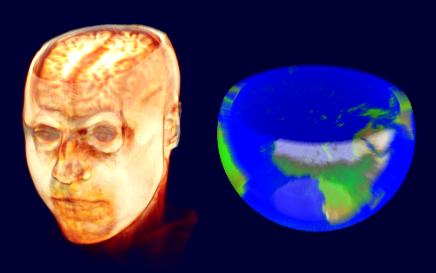 Sample of volume data. Cartesian coordinets can be converted to spherical or other coordinates by modifier.
Sample of volume data. Cartesian coordinets can be converted to spherical or other coordinates by modifier.

VolumeBox
Volume data is shown within the box. Thus, it is named as volume box.
Followings are main parameters for volume box.
Internal data format
Internal data format is 1 byte (8 bit) or 2 byte (16bit) data, i.e. each boxel has value 0 to 255 or 65535.
It is remapped to float value in range 0-1 divided by 255 or 65535 if needed as float value.
Note that source data is 1 channel data, ant it has colorless. Its color is evaluated via color curve.
Quality
Volume data is rendered as many thin slices facing at camera sequentially drawed in Z-sorted order.
Quality factor controls its inverval and number of slices. Higher is better, but with cost of rendering time.
If quality factor is too low, artifact pattern like stripes would appear.
Appropriate number is usually between 64 and 2048.
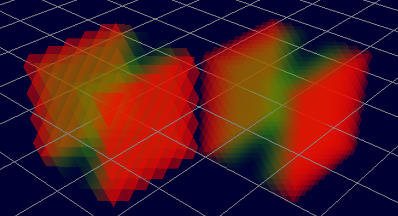 Low Quality factor samples. 16 and 32 for each image.
Low Quality factor samples. 16 and 32 for each image.
Too many slinces with very thin width (and opacity) can lead to artifact pattern due to the lack of bit-depth in internal buffer.
Second parameter determines the sampling nubmer in each slice.
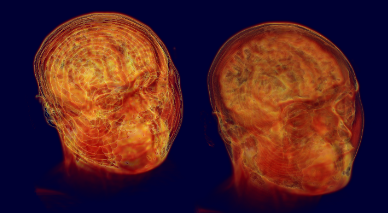 Sample for second parameter 1 and 8 (first-parameter 96)
Sample for second parameter 1 and 8 (first-parameter 96)
Smoother result can be obtained with lesser nubmer of slices.
Biased Sampling
Sometimes, high quality is required only in a limited part of data.
For example, a large thin gas with small higher density region at center.
For faster rendering, you can reduce the total number of slices by biased sampling.
This feature reduces the number of slices, except small important region.
You can select the center of volume or near side to camera as important region.
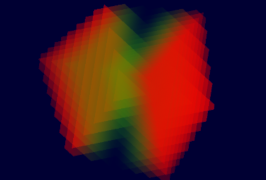 Sampling more in near side. The near side corner is rendered more smoothly than other parts.
Sampling more in near side. The near side corner is rendered more smoothly than other parts.
Factor parameter determines max reduction factor. Valid range is 1-4. (parameter 1 means no reduction)
If factor is 4, the number of slices for unimportant region is reduced up to 1/4.
Crit is criterion value. The smaller the value, the smaller region remains not reduced.
Zstack
Volume data file for a single volume data can be single file or sequential stack of 2-dimensional files (that is often image files).
With this checkbox, file reader assumes the data is stacked as sequential images.
Filepath
Currently Zindaiji4 can read z-stacked image fies or .df3 file, or openVDB file as a single volume data.
Reading openVDB is experimental.
It only read one grid (default name is "density"), and a active data.
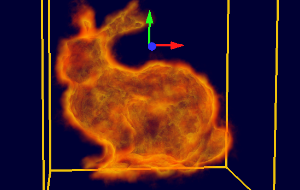 Open VDB Sample Data.
Open VDB Sample Data.
df3 format is an simple binary data that the data is stored in z-y-x ordered loop.
A filename the should be set here is the first file of file sequence, or input its format for sequence directly.
Format for direct input of time sequential data must be written like printf or scanf format in C anguage. Thus, sequential df3 file is expressed data%04d.df3.
data0000.df3
data0001.df3
data0002.df3
...
If volume is z-stacked image files, file must be two-dimensinal sequence such as imgT%04dZ%04d.png
imgT0000Z0000.png
imgT0000Z0001.png
.....
imgT0001Z0000.png
imgT0001Z0001.png
.....
Currently, order of sequence is fixed and not configurable. It is assumed that T is first and Z is last ones.
offset
If file sequence is set with %0xd format, it is assumed that it start with 0. If file sequence does not start at 0, set offsets by this parameters.
Auto Rescaling
Initially, size of volume box is set to 1x1x1. If volume data is not squared one, it must be adjusted manually.
This button automatically adjust size according its x-y-z resolution of the data assuming its aspect ratio of its boxel is 1.
For example, if the data has its size 256x128x64, the size of box is set to 1 x 0.5 x 0.25.
Reload
Reload the data. It is convenient if data you are viewing is temporay test data files that would be overwritten oftenly.
Exporter
Zindaiji4 can export DF3 file or Image Sequence files, so that you can convert image sequence data to DF3 or vice versa.
You can export the raw data in each snap as Zindaiji4 has just read (Snap Data), or interpolated data between each step (interpolated data).
Isosurface
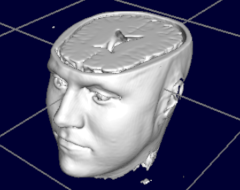 Sample image of isosurface
Sample image of isosurface

Geometry of isosurface is treated separetely to the volume data on what the isosurface is based.
To show isosurface in the same geometry to that of volume, parent-child relationship can be used.

Isosurface
Isosurface makes its shape based on a target volume data.
Link
Select target volume.
Threshold
A threshold value to make isosurface shape.
Optimize
Simply made isosurface data may have overlapping vertices. Optimization removes a part of (not all) these vertices and reduce data size, and makes drawing faster.
However, optimization itself takes some time, so that it may become slower in some cases such that reconstruction of isosurface in every frame is needed.
Use VBO
Use VBO in display process. VBO is a dataset stored in the graphic board memory, and display speed is much faster than that stored in main memory.
However, making VBO itself takes some time, so that it may become slower in some cases such that reconstruction of isosurface in every frame is needed.
Particles
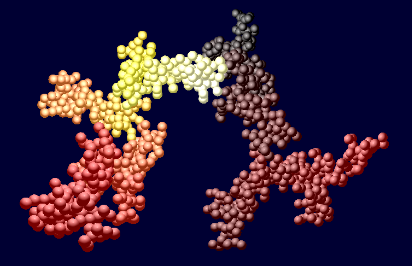 Sample of Particle data.
Sample of Particle data.

Particle
Particle system is static or time-dependent assembly of items. To show particles, they must have x,y,z and size information individualy. (Size would be set to 1 if no size data is read.) Followings are main parameters for particles
Classify
Particles with different type can be shown with different material properties. Basically, particles are classified by its own type data.
You can overwrite type of particles with LUA exprssion. For example, you can set particle with index < 256 to be type 0 and others to be type 1 with following scrit.
if (index < 256) then return 0 end
return 1
|
If Text Editor is on scree, you can link the script for classification to the Editor by Edit button.
Sort
Without sorting, partilces are displayed in order of thier indices. For non-semitransparent particles, the order of displaying have no effect on the results.
If particles are seme-transparent, it must be re-ordered according to distance from camera.
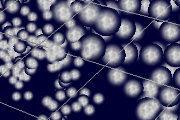
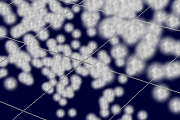
Without the re-ordering, the nearer particles may not hide further particles in correct way.
This option determine the way the particles would be sorted.
Sorting with not-Z (or distance) information is used for special way of rendering.
In ordinary case, only the front size of camera is rendered, so that Z-directional sort is good enough for approximation. However, in the cases of fisheye or equirectangular rendering, more precise (but somewhat hevier) sort with distance to the camera is necessary.
Sorting is a heavy process. When "Distance (skip sort") is selected, distance form camera would be calculated but skip sort process. This selection is used for modifiers that uses distance information, but sort is not necessary.
Sort Frequency
When position or direction of camera changes only a little, the sort process is often not necessary. If this factor is set under 1, the condition for sort process becomes easier and display speed would be faster. Of course, if the condition is too much easy, rendering would be unprecise one.
DepthMask
In normal process for rendering, depth information is drawn in depth-buffer, and that buffer is used to compare whether the newly drawing polygon is near the camera than previously drawn polygon or should be hidden.
When this checkbox is not checked, drawing in depth buffer is skipped. This option may be useful in some special way of rendering.
Filepath
A filenname that should be set here is the first file of file sequence, or input its format for sequence directly.
Format for direct input of time sequential data must be written like printf or scanf format in C anguage. Thus, sequential file is expressed as data%04d.txt for example.
data0000.txt
data0001.txt
data0002.txt...
Data Sequence
Is this is unchecked, the data would be read as a single snap shot, even if the file is sequentially named.
Offset
If file sequence is set with %0xd format, it is assumed that it start with 0. If file sequence does not start at 0, set offsets by this parameters.
If file sequence does not start at 0, set offsets by this parameters.
Cast Shadow
If unchecked, the particles would not cast shadow even if shadow volume process is turned on.
Random Twist
Randomly twist the billboards, to prevent them from aligned in one way. This can be important when you use billboard textures with less symmetricity.
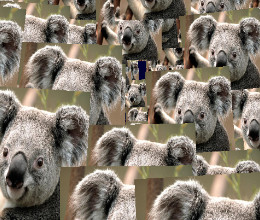
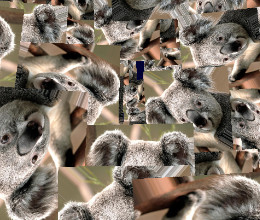
Reload
Reload the data. It is convenient if data you are viewing is temporay test data files that would be overwritten oftenly.
Material

Material settings for particles is rather different than other object. The largest difference is that it can have multiple materials.
If particles have data of its type, particles of type 0 would be shown with material.0, partile of type 1 would be shown with material.1, and so on.
For details of material, see the page for Material for Particles.
Format

File format to read particle data is editable to some extent. Editor is in format tab in Property Panel.
Streamline
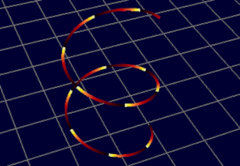 Sample image of streamline.
Sample image of streamline.
It is assumed to be used to show streamlines.
However, no functioality to generate streamline from vector field is implemented yet. This object shows just multiple lines accordingt to given data set.
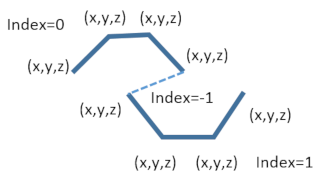
Data structure of lines are similar one to that of particle data. Instead of showing particle at each vertices, lines are drawn between vertices like an one-stroke sketch.
Each vertex has index value for line, and if index is -1, that line is ignored. In this way, not only one-stroke lines, but many divided lines can be draw.
This index is nothing to do with the order of line drawing. Just used distinguish individual line in process such as downsizing.
Note that with a vertex with index -1, the line between that and previous vertex becomes invisible.
When vertices are like following ones,
vertex0(index=0)
vertex1(index=0)
vertex2(index=-1)
vertex3(index=1)
the line stroke would be like as
vertex0-----vetex1--x--vertex2----vertex3

Streamline
File path/Offset
A filename to read. The rule for sequential file is similar to volume or particle data sequence.
Sequential
To read sequential files as a snapshot, remove check from this.
Material

Material settings for streamline has several different points than that of other objects.
See material for streamline for details
Format

Currently, only 2 simple ascii format can be read.
Vertex data for each line, and each line must be
x y z u (index)
or
x y z u value1 (index).
index can be ignored. If so, index starts from 0 and increments for every vertex with index -1.
HeightField
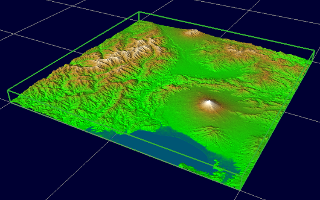
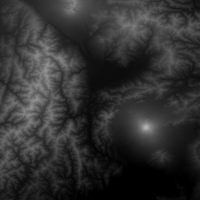 Height Field convert image data to a 3D object with height according to its color components.
Height Field convert image data to a 3D object with height according to its color components.
Most common use is to make object from geological data in image file format.

HeightField
FilePath / offset
A filename to read. The rule for sequential file is similar to volume or particle data sequence.
The file to read is a imagefile. Image format png, jpg, tiff, tga and bmp is acceptable.
As for high dynamic range image, 16 bit-png reader is implemented. (Not converting to 8 bit image, but Zindaiji3 retains its full 16bit data.)
Image Sequence
Often, separate image files (that is not image sequence, but just two different image) has names such as img0001.png and img0002.png. In such case they woud be (wrongly) interpreted as 2-step image sequence.
You can explicitly tell that a image is not a part of sequential images by unchecking this checkbox.
Rim
Add Rim and bottom side face for the height field.
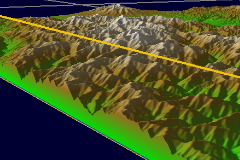
Channel
Though height field needs only height information, an image file can have multiple channels (R, G, B, and Alpha).
You can selelet which channel (R, G, B, luminocity, and norm.) would be used for height field.
A formula sqrt( 0.299*R^2 + 0.587*G^2 + 0.114*B^2 ) is adopted here for luminocity.
Option
X-ray and Cast Shadow options are same for that of primitive object.
return



 Sample of volume data. Cartesian coordinets can be converted to spherical or other coordinates by modifier.
Sample of volume data. Cartesian coordinets can be converted to spherical or other coordinates by modifier.
 Low Quality factor samples. 16 and 32 for each image.
Low Quality factor samples. 16 and 32 for each image. Sample for second parameter 1 and 8 (first-parameter 96)
Sample for second parameter 1 and 8 (first-parameter 96) Sampling more in near side. The near side corner is rendered more smoothly than other parts.
Sampling more in near side. The near side corner is rendered more smoothly than other parts. Open VDB Sample Data.
Open VDB Sample Data. Sample image of isosurface
Sample image of isosurface

 Sample of Particle data.
Sample of Particle data.






 Sample image of streamline.
Sample image of streamline.




 Height Field convert image data to a 3D object with height according to its color components.
Height Field convert image data to a 3D object with height according to its color components.
